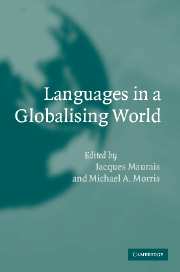Book contents
- Frontmatter
- Contents
- List of figures
- List of tables
- Notes on contributors
- Acknowledgements
- 1 Introduction
- Part I Global communication challenges
- Part II Major areas
- 7 Language geostrategy in eastern and central Europe: Assessment and perspectives
- 8 Languages and supranationality in Europe: The linguistic influence of the European Union
- 9 Regional blocs as a barrier against English hegemony? The language policy of Mercosur in South America
- 10 Effects of North American integration on linguistic diversity
- 11 Sociolinguistic changes in transformed Central Asian societies
- 12 Language and script in Japan and other East Asian countries: Between insularity and technology
- 13 Sub-Saharan Africa
- 14 Australasia and the South Pacific
- Part III Languages of wider communication
- Conclusion
- Index
11 - Sociolinguistic changes in transformed Central Asian societies
Published online by Cambridge University Press: 18 November 2009
- Frontmatter
- Contents
- List of figures
- List of tables
- Notes on contributors
- Acknowledgements
- 1 Introduction
- Part I Global communication challenges
- Part II Major areas
- 7 Language geostrategy in eastern and central Europe: Assessment and perspectives
- 8 Languages and supranationality in Europe: The linguistic influence of the European Union
- 9 Regional blocs as a barrier against English hegemony? The language policy of Mercosur in South America
- 10 Effects of North American integration on linguistic diversity
- 11 Sociolinguistic changes in transformed Central Asian societies
- 12 Language and script in Japan and other East Asian countries: Between insularity and technology
- 13 Sub-Saharan Africa
- 14 Australasia and the South Pacific
- Part III Languages of wider communication
- Conclusion
- Index
Summary
Multilingualism – from the point of view of both societies and individuals – is a striking characteristic of Central Asia. An exceptionally high mobility among ethnic populations in earlier periods due to nomadism, wars, trade, migration for political or economic reasons and even deportations has been the natural cause of language contact and the interference of one language into another or the functional dominance of one language over the other. In addition to this, throughout the twentieth century linguistic patterns in Central Asia have been in a constant process of politicised and rapid reorganisation. Finally, with the new large-scale sociopolitical developments taking place in the region since the Soviet collapse, traditional language settings are subject to considerably different conditions from those of the past. To a much greater extent than before future research on not only major languages and public language practice, but also minority language settings in Central Asia, will have to take into account the overall sociopolitical conditions and official programmes of the societies to which these settings belong.
In contemporary research Central Asia is generally given a wide definition delimiting a territory almost as large as that of Canada, from the Caspian Sea in the west to the Hinggan Mountains to the east of Mongolia, and from the Iranian Plateau, the Himalayas and Tibet in the south to the Siberian steppe lands in the north. In the western part of Central Asia there are now, for the first time after centuries of foreign interference and hegemony, truly independent states: the former five Soviet republics of Kazakhstan, Kirghizstan, Uzbekistan, Turkmenistan and Tajikistan.
- Type
- Chapter
- Information
- Languages in a Globalising World , pp. 157 - 187Publisher: Cambridge University PressPrint publication year: 2003
- 9
- Cited by



